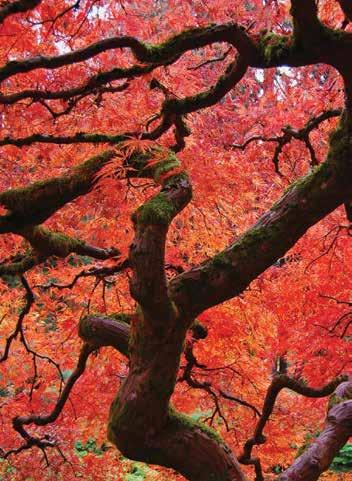
8 minute read
Birmingham Gardening Today
Perfectly Pruned
Japanese Maple Tree Flowering Crabapple Tree

Bring a sense of artistry to your garden with a variety of sculptural trees and shrubs. All you need is some creativity, a little elbow grease, and these tips from gardening expert John Floyd.
the cold months for gardening are here. is is the time of year when the small things in the garden become more noticeable. Any plant that blooms in winter stands out among the deciduous landscape and gray skies in the background. e blooms display a brightness you don’t often see in other seasons. And while winter’s oral landscape may be limited to only a few annuals, perennials, and shrubs, the sculptural qualities of our shrubs and trees also take center stage in this period. One of the most sculptural small trees—and a favorite of mine—is the Japanese maple. e tree must be pruned regularly in order to maintain its beautiful shape.
Excellent examples of sculptured Japanese maples in all stages of development can be found in the Japanese Gardens at the Birmingham Botanical Gardens. If you want to start sculpting yours at home, keep in mind that it takes time—and a bit of artistry—to get them to look like the ones in the Japanese Garden. First, I remove all
John Floyd has been gardening in the Birmingham area for more than 30 years. In addition to his day-today experience, John has degrees in horticulture from Auburn and Clemson Universities and was editor-in-chief of Southern Living.
the crossing branches in the plant. If this severely prunes the tree, that may be enough for this season. If not, this is the time to tap into your artistic side by imagining what you want the tree to look like when nished. I have been working on one that I pictured with a multi-stem look. In order to achieve that, I thinned the canopy and removed all the limbs up to 6 feet high. In the canopy, I removed all the tiny limbs. Going forward, my work each year will be to remove dead branches and “hand-shave” all the leaves and small shoots. While my example is a simple one, the beauty of the Japanese maple is that it allows you to be as creative as you desire. Other trees that are good for sculpting include Japanese magnolia, crepe myrtle, owering crabapple, owering dogwood, southern sugar maple, and live oak.
Some of the most overlooked winter plants are the minor bulbs. ey are generally less than 6 inches tall and therefore need to be planted in a mass for any type of e ect. Start looking to buy these in early January as you might nd them marked down. e most well-known minor bulb is the crocus. ere are over 10 species of crocus, so make sure you select types that bloom in January and February. Selections I like include Snow Bunting, Cloth of Gold, and any of the tommasinianus selections. Muscari is another great minor bulb for our area. I have not grown all the selections, but the clumps at my house have started blooming as early as midFebruary. Anemone blanda selections, while technically not bulbs, also enjoy our climate.
Of all the minor bulbs, my favorite is the early- owering dwarf da odil. Once established, it can grow in large clumps to create carefree winter color. Tête-àTête, Rip van Winkle, and Petticoat


DON’T MISS...
Have you visited the Library at
Birmingham Botanical Gardens?

Muscari


Anemone Blanda Rip van Winkle Daffoldils Snow Bunting Crocus

Floyd’s To-Do List: January/February
Remove burned, damaged, or dead leaves from small plants like Lenten roses, Nippon lilies, Japanese ardesia, and any of the ornamental grasses that are broken or just look tired. I also like to cut back liriope, which I do yearly, as well as mondo grass if needed. A string trimmer or hand clippers work well for this chore. First, make sure the cut back is even. For liriope, the leaves that have fallen on the ground and those that the trimmer missed need to be removed too. After I trim these plants, I like to use a leaf rake to get all the winter material out of the cut plants. When finished, you may mulch the area if desired, but it is not necessary. Don’t forget that your pansies, violas, sweet Williams, English daisies, and other spring-flowering plants need some winter care. Pinching o dead flowers helps keep the plants attractive and encourages new flowers. I like to apply a light application of half-strength liquid fertilizer about every three weeks in winter until it warms up and you see new foliage. And finally, water the plants if there is an extended dry period or before a hard freeze is expected. This is especially important if the plants are in pots. Common camellias will show off when temperatures eventually start to warm up. To ensure they are in good shape for spring, now is the time to inspect the plants for any problems that need to be treated. To prevent camellia petal blight, remove the flowers that are covering the ground. Another common problem is camellia tea scale, which is the white fuzzy-looking stu under the leaves on the plant. Treat the plant with Bayer Advanced Tree and Shrub Insect Control. Apply according to label directions. Finally, add fresh mulch when the flowers finish and then fertilize lightly with 15-0-15.
Twigs are a major focal point in our house when there are few flowers available to cut from the garden. One of our favorite plants to cut twigs from is winged elm. I cut ours along old neglected fencerows or in abandoned lots. If you are not that adventurous, you can always purchase corkscrew willow, fantail willow, or pussy willow at your local flower source and allow them to dry in place. Other things we like to cut are red-stemmed dogwood, sweetgum, crepe myrtle, locust (with the thorns on), and Japanese magnolia (with big buds). Rose care is vital this time of year. The classic rose garden selections are to be cut back in late February, but the more common Knockout and various ground cover roses, such as Drift, need pruning di erently. For Knockout roses, you can do as little or as much as you want. The one thing I always do is remove all the dead wood. Oftentimes the plants have outgrown their space and need to be cut back, which is fine. Also, this is a good time to reshape the plant if it has grown awkwardly. The cottage-type roses like Drift, which are low growers, need to have fresh mulch put under the plants after the old mulch has been removed. Then remove all the dead leaves and shoots that are out of character for the plant. Finally, remove all the dead clusters of blooms left over from the last season. Wait to fertilize until the danger of frost has passed.
White are the selections I prefer.
I like to do a major pruning of my shrubs (except for mophead hydrangeas) in February. If you are wanting to severely prune a really large shrub, it’s important to think about what your goal is for the plant. If it’s just too big for the space, you might want to simply remove it and select another plant that will not grow as big. But if you choose to prune the shrub you have, be sure to look at the internal branch structure to see if the plant has a main trunk or one that is multi-stemmed from the ground. If it is a single-trunk plant and you cut the top out of it, the new growth will come from that spot with multiple new shoots. In this case, I would not prune to the height you ultimately desire. Instead, prune the shrub much lower and let it grow to the desired size. As for the side shoots, remove those with this same thought in mind.
Remember that severe pruning of these plants usually leaves them looking like a bunch of sticks. If the plant has all of its stems coming from the base, you have two options. One is to cut every limb within a foot of the ground and let it regrow into its natural form. e other option is to simply reduce the height or width by taking the tallest (or widest) limb and chasing it back to twice the height (or width) you desire. Cut as many branches as needed to reduce the size. e plant may still look skimpy until new shoots and foliage appear. Follow these steps to reduce the size of most shrubs (except boxwood) in your garden with good results. Keep in mind that boxwood may not recover from a severe pruning.
For daily tips and more garden information, visit birminghamgardeningtoday.com or birminghamhomeandgarden.com.
Children born into all kinds of circumstances have dreams and dreams are powerful.
WE DO WHAT WE DO BECAUSE CHILDREN HAVE DREAMS.

1600 7TH AVENUE SOUTH BIRMINGHAM, AL 35233 (205) 638-9100 ChildrensAL.org
Social MediaSocial Media
L O G O C O L L E C T I O N
L O G O C O L L E C T I O N





